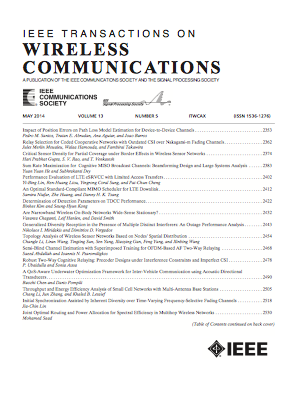6G网络多功能RIS集成传感与通信
IF 10.7
1区 计算机科学
Q1 ENGINEERING, ELECTRICAL & ELECTRONIC
引用次数: 0
摘要
在本文中,我们提出了一种新的多功能可重构智能表面(MF-RIS),它同时支持信号反射、折射、放大和目标感知。我们的MF-RIS旨在增强集成通信和传感(ISAC)系统,特别是在多用户和多目标场景中。配备反射和折射组件(即放大器和移相器),MF-RIS能够根据需要调整通信和传感信号的幅度和移相。此外,在传感元件的帮助下,MF-RIS能够捕获来自多个目标的回波信号,从而减轻通常与多跳链路相关的信号衰减。我们提出了一个基于mf - ris的多用户多目标ISAC系统,并制定了一个优化问题,以最大化传感目标的信噪比(SINR)。该问题涉及在通信速率、总功率预算和MF-RIS系数约束下,对发射波束形成和MF-RIS配置进行联合优化。我们将公式化的非凸问题分解为三个子问题,然后通过有效的迭代算法求解它们。仿真结果表明:1)在不同的操作协议下,MF-RIS的性能存在差异,在考虑启用MF-RIS的多用户多目标ISAC系统中,能量分裂(ES)表现出最好的性能;2)在相同的总功率预算下,采用ES协议的MF-RIS分别比主动RIS、被动RIS和同步发射和反射RIS (STAR-RIS)获得$\rm{52.2} %$、$\rm{73.5} %$和$\rm{60.86} %$的传感SINR增益;3)传感元件数量超过一定数量后,传感性能不再提高。本文章由计算机程序翻译,如有差异,请以英文原文为准。
Multi-Functional RIS Integrated Sensing and Communications for 6G Networks
In this paper, we propose a novel multi-functional reconfigurable intelligent surface (MF-RIS) that supports signal reflection, refraction, amplification, and target sensing simultaneously. Our MF-RIS aims to enhance integrated communication and sensing (ISAC) systems, particularly in multi-user and multi-target scenarios. Equipped with reflection and refraction components (i.e., amplifiers and phase shifters), MF-RIS is able to adjust the amplitude and phase shift of both communication and sensing signals on demand. Additionally, with the assistance of sensing elements, MF-RIS is capable of capturing the echo signals from multiple targets, thereby mitigating the signal attenuation typically associated with multi-hop links. We propose a MF-RIS-enabled multi-user and multi-target ISAC system, and formulate an optimization problem to maximize the signal-to-interference-plus-noise ratio (SINR) of sensing targets. This problem involves jointly optimizing the transmit beamforming and MF-RIS configurations, subject to constraints on the communication rate, total power budget, and MF-RIS coefficients. We decompose the formulated non-convex problem into three sub-problems, and then solve them via an efficient iterative algorithm. Simulation results demonstrate that: 1) The performance of MF-RIS varies under different operating protocols, and energy splitting (ES) exhibits the best performance in the considered MF-RIS-enabled multi-user multi-target ISAC system; 2) Under the same total power budget, the proposed MF-RIS with ES protocol attains $\rm {52.2}\%$ , $\rm {73.5}\%$ , and $\rm {60.86}\%$ sensing SINR gains over active RIS, passive RIS, and simultaneously transmitting and reflecting RIS (STAR-RIS), respectively; 3) The number of sensing elements will no longer improve sensing performance after exceeding a certain number.
求助全文
通过发布文献求助,成功后即可免费获取论文全文。
去求助
来源期刊
CiteScore
18.60
自引率
10.60%
发文量
708
审稿时长
5.6 months
期刊介绍:
The IEEE Transactions on Wireless Communications is a prestigious publication that showcases cutting-edge advancements in wireless communications. It welcomes both theoretical and practical contributions in various areas. The scope of the Transactions encompasses a wide range of topics, including modulation and coding, detection and estimation, propagation and channel characterization, and diversity techniques. The journal also emphasizes the physical and link layer communication aspects of network architectures and protocols.
The journal is open to papers on specific topics or non-traditional topics related to specific application areas. This includes simulation tools and methodologies, orthogonal frequency division multiplexing, MIMO systems, and wireless over optical technologies.
Overall, the IEEE Transactions on Wireless Communications serves as a platform for high-quality manuscripts that push the boundaries of wireless communications and contribute to advancements in the field.

 求助内容:
求助内容: 应助结果提醒方式:
应助结果提醒方式:


